Rising temperatures can mean a lot of things to many people. It can mean summer break, beachside vacations, or afternoons sipping lemonade by the pool. Maybe it means water skiing at the local lake or fishing late into the evening, hoping for one more bite. But for homeowners, it means the arrival of numerous troublesome pests, each one more frustrating than the next. Perhaps the most despised of all warm-weather pests, and a frequent concern of EcoShield customers, are the various stinging insects that start to pop up. Of these unwelcome visitors, one seems to always rise to the top of the list of concerns: European hornets.

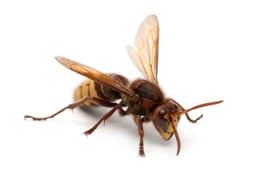
What are european hornets? differences between wasps, bees, and hornets.
While bees, wasps, and hornets are all of the same order of insects called Hymenoptera, they’re not necessarily the same insects. Wasps and bees are both in the suborder Apocrita, meaning while they have many class similarities, they’re very separate insects. The suborder Apocrita is composed of wasps, bees, ants, and most parasitic forms. You may notice that hornets are not specifically mentioned in that list. This is because hornets are actually just a variety of wasp, much like mud daubers and yellowjackets. It’s important to know that while all hornets are wasps, not all wasps are hornets.
Bees are winged pollinators that are made up of 16,000 different species. Given their broad classification, it will come as no surprise that not all bees are created equal. Some species like honeybees and bumblebees are considered social and live in colonies, while the vast majority of bees are solitary. Solitary bees include carpenter bees, digger bees, mason bees, leafcutter bees, and sweat bees. Bees are an abundant and resilient insect, living and thriving on every continent except Antarctica.
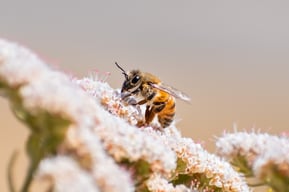
Bees are quite different from wasps in a few ways, but most noteworthy are their physical differences. Most bees can be identified by their short, thick bodies and fuzzy appearance. Bees can vary greatly in size and in color, too. Our homeowners commonly encounter bees that are brown or yellow and black in color, but some bee species are blue, green, red, white, or even purple!
Wasps, on the other hand, tend to have a much sleeker look than their bee cousins. Wasp’s bodies are generally slender, smooth, and relatively hairless when compared to bees. Wasps also have pointed lower abdomens and an identifiable small, pinched “waist.” These insects are typically between ¼” and 1” long and can appear in a variety of vibrant colors from well-known brown or black and yellow to bright red, metallic blue, and black.
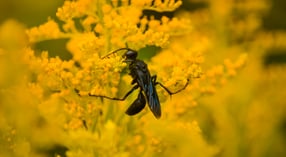 Great Black Wasp, Flickr
Great Black Wasp, Flickr
European hornets (which again, are just a subset of wasps) are considerably large insects, measuring between 2 and 3.5 cm in adulthood. These insects have large but slim yellow and black striped abdomens with a red-brown head and large eyes. European hornets also have long, red-brown legs and corresponding antennae.
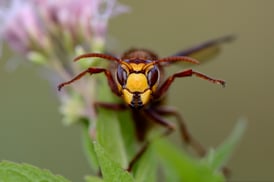
European hornet behavior and nesting habits
European hornets are the largest eusocial wasps that are commonly found in the United States (though they are native to Europe.) As social wasps, their colonies can grow anywhere from 200 up to 500 wasps. Needless to say, large wasps appearing in the hundreds are an obvious concern for many homeowners, especially due to their nests frequently occurring near homes. European wasps like to build their nests anywhere there is a hollow cavity. Some of the more common spots include attics, chimneys, holes in trees, between walls, and sometimes even underground.
European hornet nests are rarely fully exposed or visible to the naked eye, however nests will sometimes extend past their hollowed cavities as they grow in size. Their nests are brown and paper-like in texture and are usually shaped somewhat like a football. You’ll likely not be able to see the comb-like structure within the nest as the hornets will build a thin layer of paper-like material on the outside. This layer is primarily intended to form as protection from any elements the nest may be subject to.
Largely carnivorous, European hornets prey on a variety of large insects. Some common ones include dragonflies, medium-to-large moths, wasps, mantises, and beetles. Unlike other wasp varieties, European hornets are active both day and night. Because of this, their food sources include a vast array of nocturnal insects, as well. With that said, this means European hornets are susceptible to falling prey to both day and night dwellers including birds, bats, frogs, spiders, lizards, hedgehogs, and badgers.
European hornet aggression towards humans
Many people fear European hornets due to their large size (and stingers!) Luckily, European hornets are not generally regarded as aggressive in nature. These hornets are some of the best examples of, “if you don’t bother them, they won’t bother you.” Typically, European hornets will not attack humans unprovoked, unlike some other more aggressive wasp varieties. But like all stinging insects, they will defend themselves and their nests.
Most hornet stings will occur when humans either intentionally or unintentionally threaten them. This can happen when one accidentally stumbles into a European hornet’s nesting site, which can be common due to their out-of-the-way locations. When someone enters their territory and is perceived as a threat, that is when the European hornet’s hostility will show. They will aggressively defend their nests and become otherwise uncharacteristically hostile. The same can be said if you come between a European hornet and its food. (I guess we all get hangry!)
It’s important to note that European hornets, like all wasps, can sting multiple times. This is because they do not lose their stinger after stinging like some of their bee cousins. The European hornet sting is painful, though no more than other wasp’s stings. While there is a myth that hornet stings are enough to kill a human, this is simply not true. The only time in which a human would be at risk of serious injury from a European hornet sting would be in the event of an allergic reaction. If this should occur, it is recommended that you seek medical attention immediately.
Preventing wasp and hornet nests in or around your home
In the hot summer months, it’s not uncommon to encounter wasps and bees of all kinds around your home. Some may just be passing through, but there’s a good chance a few are building nests nearby either on your property or, worse, inside your home! Due to the European hornet’s nesting habits, they are frequently found in and around homeowner’s houses. While it may not be possible to entirely prevent wasps and hornets building nests nearby, there are a few ways to deter them and make your spaces less appealing.
- Seal entrances to your home. Fix, caulk, and seal any potential entry points in your home’s roof, siding, windows, attics, and basements that hornets may use to enter your home.
- Keep hummingbird feeders or nectar-rich flowers away from commonly used outdoor spaces like porches or decks.
- Properly seal outdoor trash cans with well-fitting lids and keep them away from recreational spaces.
- Immediately clean up trash, food scraps, or spills that may attract insects. Cover food when eating outdoors or grilling for guests. Do not leave food outdoors unattended for extended periods of time.
- Immediately treat other insect infestations that may serve as a food source and attract hornets.
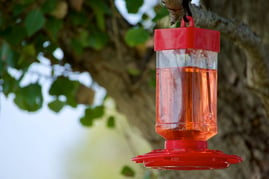
What to do if you encounter a European hornet’s nest
If you suspect there is a European hornet’s nest in or around your home, please do not attempt to treat it yourself. Although they are not typically aggressive, European hornets will fiercely protect their nests and attack anything they perceive to be a threat. By attempting to spray or knock down a hornet’s nest, you will be at risk of an entire colony coming to defend their home with stingers at the ready. Please remember that European hornets can and will sting multiple times, especially if provoked. Not only are DIY-attempts potentially ineffective, but they can also be very painful!
How to get rid of European Hornets
Your best bet for effective, safe, and long-term hornet removal is to contact a reputable pest control company like EcoShield at the first sign of an infestation. EcoShield’s experienced pest professionals are trained in safe nest removal practices and will return if the hornets do. Hornet removal is covered by EcoShield’s Home Protection Plan, but we also offer a one-time treatment option for wasp and hornet removal. For the safety of you and your family, we do not recommend self-treatment of any pests, let alone stinging insects. Call EcoShield for 100% guaranteed European hornet removal all summer long.
.png?width=271&name=MicrosoftTeams-image%20(3).png)